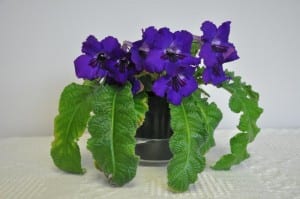
By Dawn Pettinelli, Manager, Soil Nutrient Analysis Laboratory
Watering seems like such a simple but many are surprised to know that improper watering is the main cause of houseplant demise. Excess water will drain away in outdoor garden soils. However, houseplants are confined to a container and excess water remains in the saucer or cachepot unless removed. This causes the potting medium to remain saturated and displaces necessary oxygen, resulting in root death or deterioration, meaning roots will take up less water and the plant appears wilted.
Proper watering techniques will promote healthy root growth. Instead of watering plants by the calendar, check them frequently to evaluate their moisture needs. Stick your finger into the potting mix and feel for moisture about an inch below the surface. If the planting medium feels dry, give the plant a thorough deep watering. Light watering encourages poor root growth. Keep in mind that plants will dry out faster when temperatures are higher and when exposed to heat sources, as is often the case during the winter months. Apply enough water so that after about a minute, excess water will be observed seeping out of the drainage holes. Empty saucers or cachepots containing water within an hour or so of watering.
When the rooting medium is excessively dry, it pulls away from the pot and water will run rapidly down the sides of the pot into the saucer without saturating the root zone. To rewet the potting mix and the roots, submerge the whole pot in a sink or pail full of water until air bubbles stop appearing. Then let the pot drain well before returning it to its regular site.
Plants with thick or waxy leaves or plants with few leaves will require less water than plants with many, soft, lush leaves. Size and type of container influences the amount and frequency of watering. Unglazed clay pots dry out quicker than plastic or glazed pots. Plants in too small a container need to be watered more often and should be transplanted in to a larger pot. Plants growing in pots too big for their root system struggle using all the water the large amount of potting medium can hold and often exhibit symptoms of overwatering.
Double potting or covering the potting soil with a thin layer of organic mulch can help reduce water loss through evaporation. Normally, tap water is used to water houseplants. Water at room temperature is preferable. Chemicals present in municipal water sources may cause injury to houseplants. Filling the watering can and letting the water sit a day or so before using will often allow any harmful chemicals to dissipate causes the injury. Use of water softeners can be another problem in houseplants. Some tips to remember, collect water from outdoor taps, which are often not connected to the water softener, or even the downspout of the rain gutter, or consider purchasing bottled water. Try a self-watering container or wick watering system if you are a forgetful waterer at times. The better you accommodate your plants’ needs, the healthier they will be.